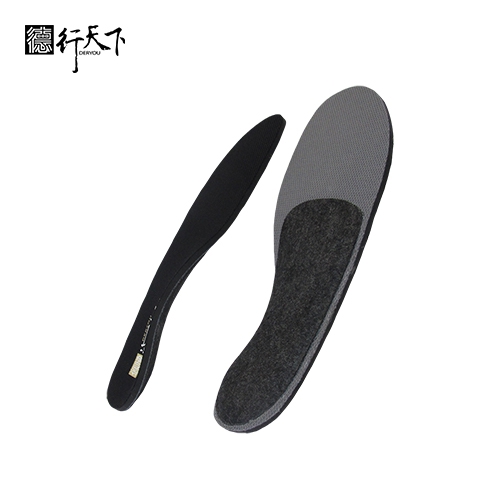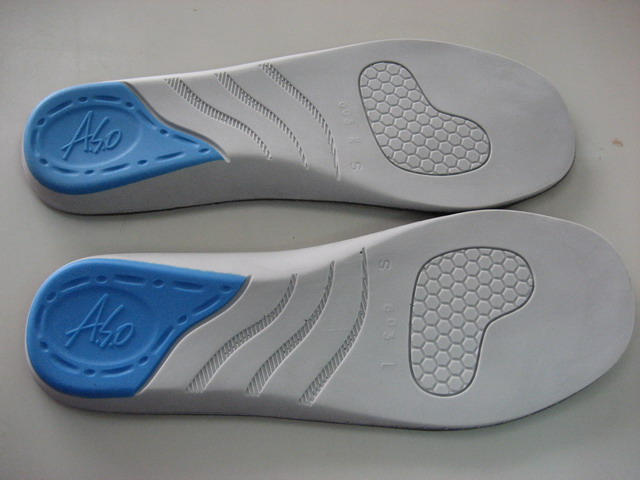Introduction – Company Background
GuangXin Industrial Co., Ltd. is a specialized manufacturer dedicated to the development and production of high-quality insoles.
With a strong foundation in material science and footwear ergonomics, we serve as a trusted partner for global brands seeking reliable insole solutions that combine comfort, functionality, and design.
With years of experience in insole production and OEM/ODM services, GuangXin has successfully supported a wide range of clients across various industries—including sportswear, health & wellness, orthopedic care, and daily footwear.
From initial prototyping to mass production, we provide comprehensive support tailored to each client’s market and application needs.
At GuangXin, we are committed to quality, innovation, and sustainable development. Every insole we produce reflects our dedication to precision craftsmanship, forward-thinking design, and ESG-driven practices.
By integrating eco-friendly materials, clean production processes, and responsible sourcing, we help our partners meet both market demand and environmental goals.


Core Strengths in Insole Manufacturing
At GuangXin Industrial, our core strength lies in our deep expertise and versatility in insole and pillow manufacturing. We specialize in working with a wide range of materials, including PU (polyurethane), natural latex, and advanced graphene composites, to develop insoles and pillows that meet diverse performance, comfort, and health-support needs.
Whether it's cushioning, support, breathability, or antibacterial function, we tailor material selection to the exact requirements of each project-whether for foot wellness or ergonomic sleep products.
We provide end-to-end manufacturing capabilities under one roof—covering every stage from material sourcing and foaming, to precision molding, lamination, cutting, sewing, and strict quality control. This full-process control not only ensures product consistency and durability, but also allows for faster lead times and better customization flexibility.
With our flexible production capacity, we accommodate both small batch custom orders and high-volume mass production with equal efficiency. Whether you're a startup launching your first insole or pillow line, or a global brand scaling up to meet market demand, GuangXin is equipped to deliver reliable OEM/ODM solutions that grow with your business.



Customization & OEM/ODM Flexibility
GuangXin offers exceptional flexibility in customization and OEM/ODM services, empowering our partners to create insole products that truly align with their brand identity and target market. We develop insoles tailored to specific foot shapes, end-user needs, and regional market preferences, ensuring optimal fit and functionality.
Our team supports comprehensive branding solutions, including logo printing, custom packaging, and product integration support for marketing campaigns. Whether you're launching a new product line or upgrading an existing one, we help your vision come to life with attention to detail and consistent brand presentation.
With fast prototyping services and efficient lead times, GuangXin helps reduce your time-to-market and respond quickly to evolving trends or seasonal demands. From concept to final production, we offer agile support that keeps you ahead of the competition.
Quality Assurance & Certifications
Quality is at the heart of everything we do. GuangXin implements a rigorous quality control system at every stage of production—ensuring that each insole meets the highest standards of consistency, comfort, and durability.
We provide a variety of in-house and third-party testing options, including antibacterial performance, odor control, durability testing, and eco-safety verification, to meet the specific needs of our clients and markets.
Our products are fully compliant with international safety and environmental standards, such as REACH, RoHS, and other applicable export regulations. This ensures seamless entry into global markets while supporting your ESG and product safety commitments.
ESG-Oriented Sustainable Production
At GuangXin Industrial, we are committed to integrating ESG (Environmental, Social, and Governance) values into every step of our manufacturing process. We actively pursue eco-conscious practices by utilizing eco-friendly materials and adopting low-carbon production methods to reduce environmental impact.
To support circular economy goals, we offer recycled and upcycled material options, including innovative applications such as recycled glass and repurposed LCD panel glass. These materials are processed using advanced techniques to retain performance while reducing waste—contributing to a more sustainable supply chain.
We also work closely with our partners to support their ESG compliance and sustainability reporting needs, providing documentation, traceability, and material data upon request. Whether you're aiming to meet corporate sustainability targets or align with global green regulations, GuangXin is your trusted manufacturing ally in building a better, greener future.
Let’s Build Your Next Insole Success Together
Looking for a reliable insole manufacturing partner that understands customization, quality, and flexibility? GuangXin Industrial Co., Ltd. specializes in high-performance insole production, offering tailored solutions for brands across the globe. Whether you're launching a new insole collection or expanding your existing product line, we provide OEM/ODM services built around your unique design and performance goals.
From small-batch custom orders to full-scale mass production, our flexible insole manufacturing capabilities adapt to your business needs. With expertise in PU, latex, and graphene insole materials, we turn ideas into functional, comfortable, and market-ready insoles that deliver value.
Contact us today to discuss your next insole project. Let GuangXin help you create custom insoles that stand out, perform better, and reflect your brand’s commitment to comfort, quality, and sustainability.
🔗 Learn more or get in touch:
🌐 Website: https://www.deryou-tw.com/
📧 Email: shela.a9119@msa.hinet.net
📘 Facebook: facebook.com/deryou.tw
📷 Instagram: instagram.com/deryou.tw
Customized sports insole ODM factory Taiwan
Are you looking for a trusted and experienced manufacturing partner that can bring your comfort-focused product ideas to life? GuangXin Industrial Co., Ltd. is your ideal OEM/ODM supplier, specializing in insole production, pillow manufacturing, and advanced graphene product design.
With decades of experience in insole OEM/ODM, we provide full-service manufacturing—from PU and latex to cutting-edge graphene-infused insoles—customized to meet your performance, support, and breathability requirements. Our production process is vertically integrated, covering everything from material sourcing and foaming to molding, cutting, and strict quality control.Vietnam flexible graphene product manufacturing
Beyond insoles, GuangXin also offers pillow OEM/ODM services with a focus on ergonomic comfort and functional innovation. Whether you need memory foam, latex, or smart material integration for neck and sleep support, we deliver tailor-made solutions that reflect your brand’s values.
We are especially proud to lead the way in ESG-driven insole development. Through the use of recycled materials—such as repurposed LCD glass—and low-carbon production processes, we help our partners meet sustainability goals without compromising product quality. Our ESG insole solutions are designed not only for comfort but also for compliance with global environmental standards.ODM service for ergonomic pillows Taiwan
At GuangXin, we don’t just manufacture products—we create long-term value for your brand. Whether you're developing your first product line or scaling up globally, our flexible production capabilities and collaborative approach will help you go further, faster.Taiwan orthopedic insole OEM manufacturer
📩 Contact us today to learn how our insole OEM, pillow ODM, and graphene product design services can elevate your product offering—while aligning with the sustainability expectations of modern consumers.Smart pillow ODM manufacturing factory Taiwan
The findings suggest that maintaining muscle strength throughout the lifespan may help protect against many common age-related diseases. Credit: Justine Ross, Michigan Medicine The study provides some of the first evidence of a link between muscle weakness and acceleration of biological age, according to researchers. People age at different rates due to a variety of intrinsic and extrinsic factors, which can affect their biological age and their risk of developing diseases or experiencing early death. This is why two individuals who are both 50 years old may not have the same level of biological aging, despite having lived for the same number of years. Lifestyle choices, such as diet and smoking, and illness all contribute to accelerating biological age beyond one’s chronological age. Researchers have discovered that grip strength, a measure of overall muscle strength, is linked to biological age in this way. In particular, the study, which was published in the Journal of Cachexia, Sarcopenia, and Muscle, found that people with weaker grip strength had older biological ages. DNA Methylation Clocks and Aging Acceleration Researchers at Michigan Medicine modeled the relationship between biological age and grip strength of 1,274 middle-aged and older adults using three “age acceleration clocks” based on DNA methylation, a process that provides a molecular biomarker and estimator of the pace of aging. The clocks were originally modeled from various studies examining diabetes, cardiovascular disease, cancer, physical disability, Alzheimer’s disease, inflammation, and early mortality. Results reveal that both older men and women showed an association between lower grip strength and biological age acceleration across the DNA methylation clocks. “We’ve known that muscular strength is a predictor of longevity, and that weakness is a powerful indicator of disease and mortality, but, for the first time, we have found strong evidence of a biological link between muscle weakness and actual acceleration in biological age,” said Mark Peterson, Ph.D., M.S., lead author of the study and associate professor of physical medicine and rehabilitation at the University of Michigan. “This suggests that if you maintain your muscle strength across the lifespan, you may be able to protect against many common age-related diseases. We know that smoking, for example, can be a powerful predictor of disease and mortality, but now we know that muscle weakness could be the new smoking.” Long-Term Observation Highlights the Impact of Grip Strength The real strength of this study was in the eight to 10 years of observation, in which lower grip strength predicted faster biological aging measured up to a decade later, said Jessica Faul, Ph.D., M.P.H., a co-author of the study and research associate professor at the U-M Institute for Social Research. Past studies have shown that low grip strength is an extremely strong predictor of adverse health events. One study even found that it is a better predictor of cardiovascular events, such as myocardial infarction, than systolic blood pressure – the clinical hallmark for detecting heart disorders. Peterson and his team have previously shown a robust association between weakness and chronic disease and mortality across populations. This evidence coupled with their study’s recent findings, Peterson says, shows potential for clinicians to adopt the use of grip strength as a way to screen individuals for future risk of functional decline, chronic disease, and even early mortality. “Screening for grip strength would allow for the opportunity to design interventions to delay or prevent the onset or progression of these adverse ‘age-related’ health events,” he said. “We have been pushing for clinicians to start using grip strength in their clinics and only in geriatrics has this sort of been incorporated. However, not many people are using this, even though we’ve seen hundreds of publications showing that grip strength is a really good measure of health.” Investigators say future research is needed to understand the connection between grip strength and age acceleration, including how inflammatory conditions contribute to age-related weakness and mortality. Previous studies have shown that chronic inflammation in aging – known as “inflammaging” – is a significant risk factor for mortality among older adults. This inflammation is also associated with lower grip strength and may be a significant predictor of the pathway between lower grip strength and both disability and chronic disease multimorbidity. Lifestyle in Preserving Health Additionally, Peterson says, studies must focus on how lifestyle and behavioral factors, such as physical activity and diet, can affect grip strength and age acceleration. “Healthy dietary habits are very important, but I think regular exercise is the most critical thing that somebody can do to preserve health across the lifespan,” he said. “We can show it with a biomarker like DNA methylation age, and we can also test it with a clinical feature like grip strength.” References: “Grip strength is inversely associated with DNA methylation age acceleration” by Mark D. Peterson, Stacey Collins, Helen C.S. Meier, Alexander Brahmsteadt and Jessica D. Faul, 9 November 2022, Journal of Cachexia, Sarcopenia, and Muscle. DOI: 10.1002/jcsm.13110 “DNA methylation patterns reflect individual’s lifestyle independent of obesity” by Ireen Klemp, Anne Hoffmann, Luise Müller, Tobias Hagemann, Kathrin Horn, Kerstin Rohde-Zimmermann, Anke Tönjes, Joachim Thiery, Markus Löffler, Ralph Burkhardt, Yvonne Böttcher, Michael Stumvoll, Matthias Blüher, Knut Krohn, Markus Scholz, Ronny Baber, Paul W Franks, Peter Kovacs and Maria Keller, 12 June 2022, Clinical and Translational Medicine. DOI: 10.1002/ctm2.851 “Prognostic value of grip strength: findings from the Prospective Urban Rural Epidemiology (PURE) study” by Dr. Darryl P Leong, Ph.D., Prof Koon K Teo, Ph.D., Sumathy Rangarajan, MSc, Prof Patricio Lopez-Jaramillo, Ph.D., Alvaro Avezum Jr, MD, Andres Orlandini, MD, Pamela Seron, MSc, Suad H Ahmed, Ph.D., Prof Annika Rosengren, MD, Prof Roya Kelishadi, MD, Prof Omar Rahman, DSc, Sumathi Swaminathan, Ph.D., Romaina Iqbal, Ph.D., Rajeev Gupta, Ph.D., Prof Scott A Lear, Ph.D., Prof Aytekin Oguz, MD, Prof Khalid Yusoff, MBBS, Katarzyna Zatonska, MD, Jephat Chifamba, MPhil, Prof Ehimario Igumbor, Ph.D., Viswanathan Mohan, Ph.D., Ranjit Mohan Anjana, MD, Hongqiu Gu, Ph.D., Prof Wei Li, Ph.D. and Prof Salim Yusuf, DPhil, on behalf of the Prospective Urban Rural Epidemiology (PURE) Study investigators, 13 May 2015, The Lancet. DOI: 10.1016/S0140-6736(14)62000-6 The study was partly funded by the National Institutes of Health.
An international team of researchers used one of the largest genomic datasets, consisting of nearly 4,000 Darwin’s finches, to study evolutionary changes in the iconic bird group. Published in Science, the study, building on decades of research, reveals the genetic basis of adaptation in the finches, emphasizing the importance of long-term observation for understanding evolutionary mechanisms. Genomic research on Darwin’s finches reveals key genetic factors driving rapid adaptation. An international team of researchers has recently published a landmark study on contemporary evolutionary change in natural populations. Utilizing one of the most extensive genomic datasets for animals in their natural habitats, comprising nearly 4,000 of Darwin’s finches, the research revealed the genetic basis of adaptation in this iconic group. The findings were recently published in the journal Science. Ever since Darwin wrote about the finches of the Galápagos Islands, biologists have studied these small songbirds to understand the mechanisms of evolution. One ancestral species has evolved into 18 different species in the last million years. The strength of Darwin’s finches as a study organism lies in what they can show about the early stages of speciation. Peter and Rosemary Grant (Princeton University) tracked nearly every individual on Daphne Major starting in the 1970s. Their work demonstrates that the finches of Daphne Major evolved in response to changes in the environment and interactions among species. An international team has sequenced the genomes of nearly every finch studied on Daphne and revealed the genetic architecture of adaptive change. The crater on Daphne Major from above, Galápagos Islands, Ecuador. Credit: Erik Enbody “I think it’s a really exciting opportunity to tie together our understanding of evolutionary change in the deep past with observations in current time,” says Erik Enbody, the lead author of the study and former post-doctoral fellow at Uppsala University. “Genomic data is a powerful tool to take our observations of birds in the field and learn about the factors that have shaped their evolution,” adding that this kind of study at this scale couldn’t be possible without the decades of research on Galápagos. How a Few Genes Drive Beak Variation “One of the remarkable things we found is that only a few genetic loci explain a great deal of the variation in the beak of the finch,” says Leif Andersson (Uppsala University and Texas A&M University), senior author of the study. “It seems that one of the ways these genetic changes evolve is by bundling together multiple genes, which are then subject to natural selection as the environment changes.” A Large Ground-finch (Geospiza magnirostris) on Daphne Major, Galápagos Islands, Ecuador. Credit: Erik Enbody. These results may surprise human geneticists, where many genetic variants are only responsible for a small amount of variation in human height, for instance. Over the three decades studied, the beak of the Medium Ground-Finch has become smaller. Using the genomes of all the finches on Daphne, the researchers show that this results from genes transferring from the Small Ground-Finch through hybridization and periods of drought where individuals with smaller beaks survived better. “This study highlights the value of long-term studies to understand the mechanism of evolutionary change,” says Peter Grant. Daphne Major from the sea, Galápagos Islands, Ecuador. Credit: Erik Enbody The researchers collected a drop of blood from the wing vein and banded each bird. This allowed them to track them and determine how long they survived, who they mated with, and their offspring. “By collecting blood samples throughout the study, we had the samples available for genomic study when the technology became available,” adds Rosemary Grant. A Window Into the Future of Evolution The researchers studied not only the Medium Ground-Finch, but the entire community of four species of finches present on the island. The Common Cactus-Finch experienced a gradual change towards blunter beaks as conditions on the island changed and hybridization with the Medium Ground-Finch increased. This study paints a dynamic picture of how species adapt to changing environments through a combination of genetic changes of large phenotypic effects that are sometimes transferred between species. As the global environment continues to change, the finches of the Galápagos island will provide a valuable window into understanding how birds, their genetic constitution, and their environment interact to shape the future of wild populations. Reference: “Community-wide genome sequencing reveals 30 years of Darwin’s finch evolution” by Erik D. Enbody, Ashley T. Sendell-Price, C. Grace Sprehn, Carl-Johan Rubin, Peter M. Visscher, B. Rosemary Grant, Peter R. Grant and Leif Andersson, 29 September 2023, Science. DOI: 10.1126/science.adf6218
Researchers using mini-brain models have found that autism spectrum disorder might stem from an imbalance in specific brain neurons essential for communication. (Artist’s concept.) Credit: SciTechDaily.com Scientists from Mayo Clinic and Yale University used organoids, or mini-brain models, to study the development of autism spectrum disorder (ASD). They discovered an imbalance in excitatory cortical neurons, which are crucial for brain communication and function. By analyzing gene expression in these neurons, they identified changes in transcription factors that may underlie ASD. The research highlights the potential of using organoids to understand brain disorders and possibly prevent ASD through prenatal genetic testing. Unraveling Autism’s Origins With Mini-Brains Using human “mini-brain” models known as organoids, Mayo Clinic and Yale University scientists have discovered that the roots of autism spectrum disorder may be associated with an imbalance of specific neurons that play a critical role in how the brain communicates and functions. The specific cells are known as excitatory cortical neurons. The study was published in the scientific journal Nature Neuroscience. Key Findings in Autism Research The team found an abnormal imbalance of excitatory neurons in the forebrain of people with the disorder, depending on their head size. “This organoid technology allowed us to recreate the brain development alteration that happened in the patients when they were in the uterus, which is believed to be the time when autism spectrum disorder originates,” says Alexej Abyzov, Ph.D., a genomic researcher in the Department of Quantitative Health Sciences at the Mayo Clinic Center for Individualized Medicine. Dr. Abyzov is a senior author of the study. Understanding Autism Spectrum Disorder Autism spectrum disorder is a neurological condition that affects the way people perceive and interact with others, leading to challenges in social communication and behavior. The term “spectrum” emphasizes the broad range of symptoms and severity, and includes autism, Asperger’s syndrome, childhood disintegrative disorder and an unspecified form of pervasive developmental disorder. Nearly 1 in 36 children in the U.S. has been identified with autism spectrum disorder, according to estimates from the Centers for Disease Control’s Autism and Developmental Disabilities Monitoring Network. Pioneering Research With “Mini-Brains” For the study, the scientists first created miniature 3D brain-like models, called organoids. The pea-sized clusters of cells began as skin cells from people with autism spectrum disorder. The skin cells were placed in a culture dish and “reprogrammed” back into a stem-cell-like state, called induced pluripotent stem cells. These so-called master cells can be coaxed to develop into any cell in the body, including brain cells. Next, the scientists used a special technology called single-cell RNA sequencing to study the gene expression patterns of individual brain cells. In all, they examined 664,272 brain cells at three different stages of brain development. The scientists also discovered that the neuron imbalance stemmed from changes in the activity of certain genes known as “transcription factors,” which play a crucial role in directing the development of cells during the initial stages of brain formation. The Future of Autism Diagnosis and Prevention This study builds on 13 years of published studies on autism spectrum disorder by Dr. Abyzov and his collaborators, including Flora Vaccarino, M.D., a neuroscientist at Yale University. In one pioneering study, they showed molecular differences in organoids between people with autism and those without and implicated the deregulation of a specific transcription factor called FOXG1 as an underlying cause of the disorder. “Autism is mostly a genetic disease. Our goal is to be able to determine the risk of autism spectrum disorder and possibly prevent it in an unborn child using prenatal genetic testing. However, this would require detailed knowledge of how brain regulation gets derailed during development. There are many aspects in which organoids could help in this direction,” says Dr. Abyzov. Reference: “Modeling idiopathic autism in forebrain organoids reveals an imbalance of excitatory cortical neuron subtypes during early neurogenesis” by Alexandre Jourdon, Feinan Wu, Jessica Mariani, Davide Capauto, Scott Norton, Livia Tomasini, Anahita Amiri, Milovan Suvakov, Jeremy D. Schreiner, Yeongjun Jang, Arijit Panda, Cindy Khanh Nguyen, Elise M. Cummings, Gloria Han, Kelly Powell, Anna Szekely, James C. McPartland, Kevin Pelphrey, Katarzyna Chawarska, Pamela Ventola, Alexej Abyzov and Flora M. Vaccarino, 10 August 2023, Nature Neuroscience. DOI: 10.1038/s41593-023-01399-0
DVDV1551RTWW78V
Innovative insole ODM solutions in China 》performance-first thinking from development to deliveryBreathable insole ODM innovation factory Taiwan 》empowering your product line with advanced material solutionsTaiwan OEM factory for footwear and bedding 》small batch friendly, big on consistency
下一則: Indonesia eco-friendly graphene material processin
限會員,要發表迴響,請先登入


